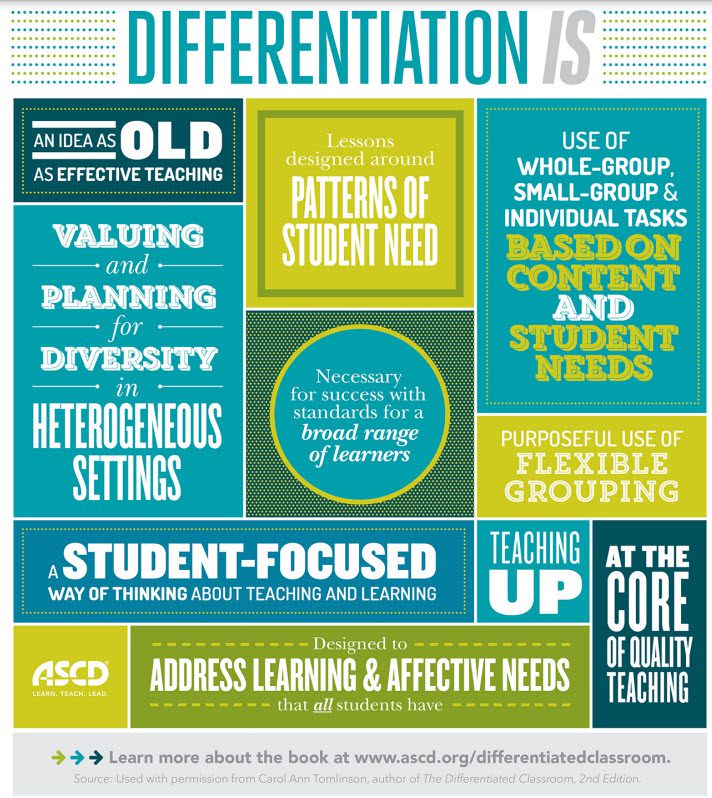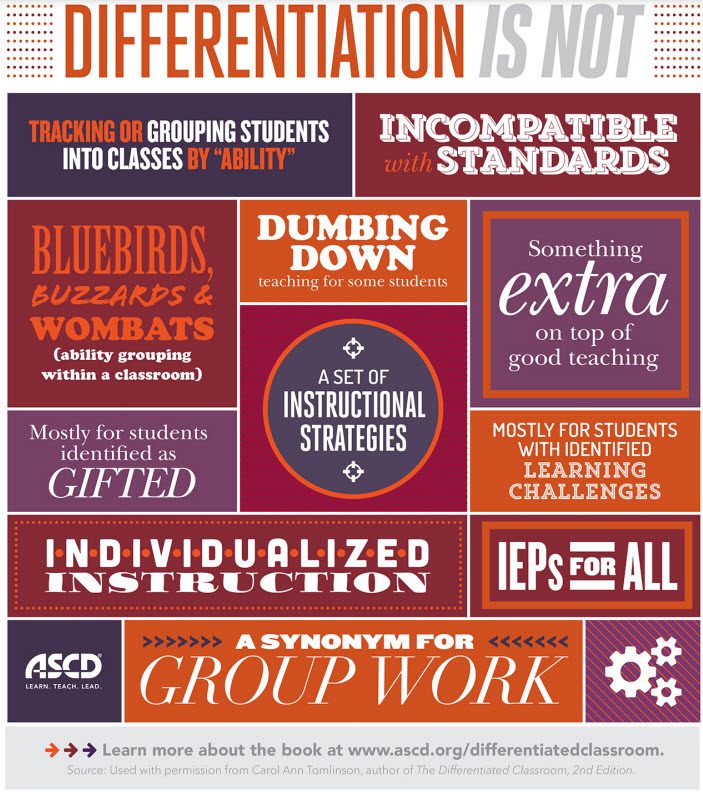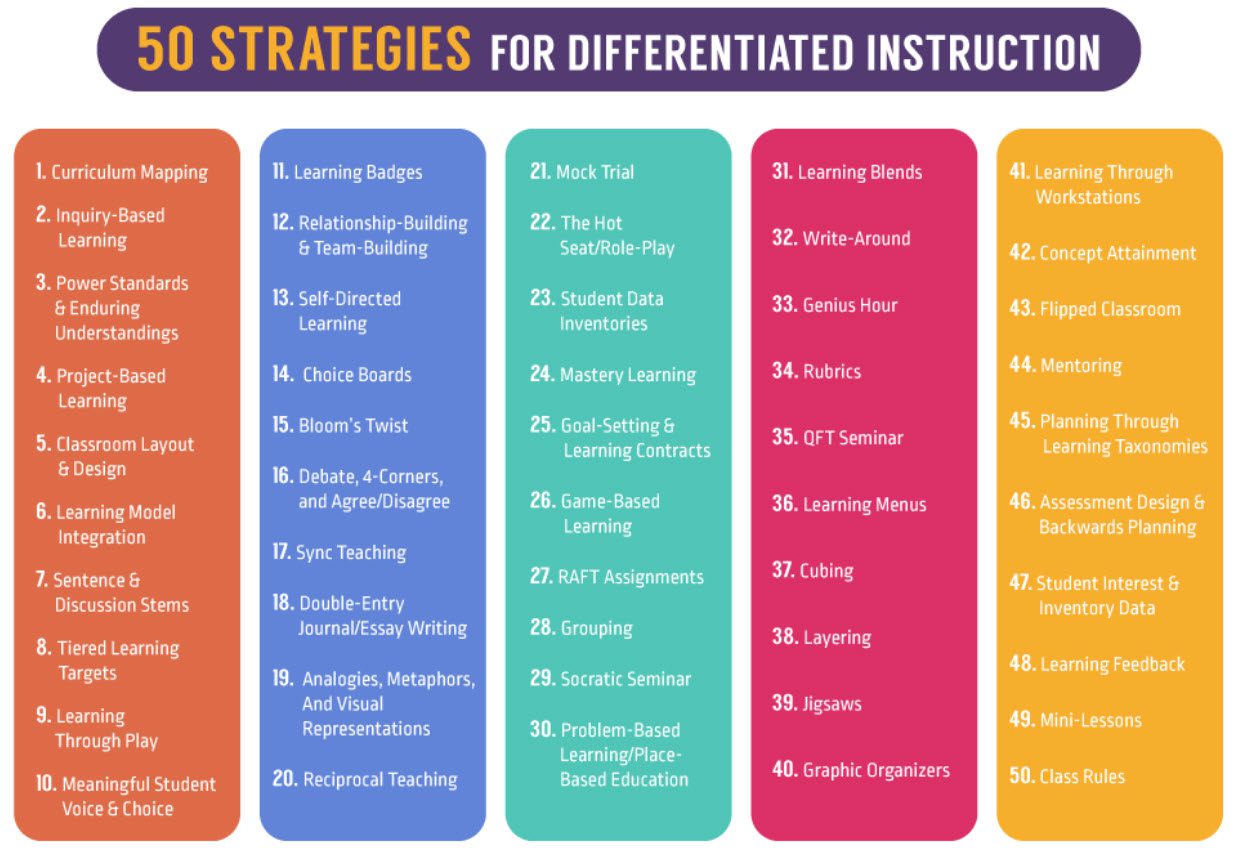In the last few decades, differentiation has become one of the biggest buzzwords in education. But what exactly is differentiated instruction, and how can teachers effectively use it in their classrooms? Read on to find out.

Source: ASCD
Differentiated instruction means tailoring your teaching so all students, regardless of their ability, can learn the classroom material. Early one-room schoolteachers were masters of differentiation. They taught students of all ages and abilities, changing up their methods as needed.
As schools moved to dividing students by age into grade levels, differentiated instruction more or less fell by the wayside. Teachers taught all students in their classroom in the same way and expected the same results. Not surprisingly, some students struggled to keep up, while others were bored when they mastered the material more quickly than others. Inclusion made these contrasts even greater, and some began to realize education needed new approaches.
During the 1990s, Carol Ann Tomlinson introduced the concept of differentiation, and it quickly gained traction. She identified four elements (content, process, product, and learning environment) that teachers could customize in their classrooms. Her work opened the door to a wide array of differentiation approaches and techniques.
Why is differentiated instruction important?

Source: ASCD
Think back to the last time you bought a pair of jeans. You probably had a multitude of choices, like slim, relaxed, or classic fit; petite, regular, or tall; stretch fabric or plain denim—the options were likely endless. Somewhere in all those options for jeans, you found the ones that were right for you. Maybe not perfect, but something that suited you better than any of the other options.
Buying jeans wasn’t always like that. A few decades ago, there were just a few styles, in different sizes. For those with a particular body type, that was just fine. But it meant many others were left with ill-fitting, uncomfortable choices, and they just had to make do. Manufacturers and stores eventually realized they needed to differentiate their styles to meet all their customers’ needs.
Just like people have different body types, they also have different learning styles and abilities. If teachers only offer one way to learn the material, some students will always struggle. Their “jeans” will never fit, and they’ll never truly master the material they need to succeed.
Differentiated Instruction and Learning Styles
In the mid-1980s, teacher Neil Fleming introduced the VARK model of learning styles. He theorized that students learned in these four general ways, known as styles, or modalities:
- Visual: Seeing images, diagrams, videos, etc.
- Auditory: Hearing lectures and having discussions
- Read/Write: Reading the written word and writing things down
- Kinesthetic: Movement and hands-on activities
In other words, some kids learn better by reading and writing, while others prefer to listen to a lecture or watch a video. Fleming noted that each student uses a mix of these different styles, and it’s important not to pigeonhole a student into any one type. The key is to ensure your teaching methods include a variety of activities that appeal to all learning types.
This concept gets right to the heart of differentiation. Recognizing that your classroom contains students with an assortment of learning styles, along with varying abilities and diverse backgrounds, is the first step toward accommodating them.
What does differentiation look like in the classroom?

So, what does this mean for teachers? Are you expected to create an individualized lesson plan for every student in your classroom? Fortunately, that’s not necessary. What you do need to do is ensure your lesson plans include a variety of activities, and provide options when students need them.
Tomlinson recommends teachers consider how they can personalize these four elements:
Content
Teachers don’t usually get to decide exactly what they’re going to teach in terms of content. Most schools use standards like Common Core to lay out what students at each level must master. What teachers often can decide is how they’ll present that content. Here are some ways to differentiate content (see more here).
- Have students read an article, watch a video, and/or listen to a lecture on a topic.
- Used leveled reading materials to help students explore the same content.
- Tailor assignments as needed, i.e., have slower workers do fewer practice problems as long as they can show mastery, while advanced students can do extra or more challenging exercises.
Process
There are so many ways to mix up the teaching and learning process. Accommodate different learning styles with various activities, and scaffold learning by breaking it into more manageable chunks. These are examples of differentiated processes (see more here).
- Create learning centers that give kids self-paced practice time in hands-on ways.
- Incorporate active learning with manipulatives, movement, and games.
- Form learning groups and use a tiered approach, with each group mastering content or skills at various speeds.
Product
It’s no secret that some kids are terrible test-takers, or that speaking in front of the class is torture for others. You can work to improve those skills, of course, but in the meantime, it’s important not to punish students because they need different ways to show their mastery of a topic. For example, unless you’re specifically teaching public speaking skills, don’t force every student to do an oral book report. Here are more ways to differentiate the product (see more examples here).
- Doing a research project? Allow students to choose how they’ll present their findings: write a paper, give a presentation, create a video, etc.
- Use a variety of question types in written tests, and help students learn good test-taking skills.
- Provide “must do” and “may do” options for assignments.
Learning Environment
Stroll the halls of a typical school, and you’ll notice that every classroom looks and sounds different. Some have desks in rows, while in others desks are pushed together or students group around tables. One is completely silent, while another bustles with discussion. Some students adapt well to these changes, but others do better in specific environments. Try to accommodate as many as you can in your space.
- Try out flexible seating—let students sit where and how they feel comfortable and ready to learn.
- Let some students wear headphones and listen to music while they work, while keeping the classroom quiet for others.
- Create calm-down corners, collaborative spaces, sensory spaces, learning centers, and more.
For more information on Tomlinson’s theories, complete the online learning module found here.
How do I get started with differentiation in my classroom?
The best teachers are those who are observant and know their students well. They watch closely as kids work (and play), and check in regularly to find out what’s working and what’s not. Try these resources to start your journey to better differentiated instruction.
Differentiated Instruction Books
Have questions about differentiated instruction and how to use it in your classroom? Join the WeAreTeachers HELPLINE group on Facebook to exchange ideas and ask for advice!
Plus, check out 20 Creative Ways To Check for Understanding.




















